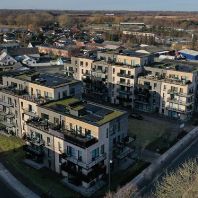The Empire State Building is 'going green' profitably. Jones Lang LaSalle and its program partners have unveiled a landmark energy sustainability program for the iconic property that will reduce the Empire State Building's energy use and greenhouse gas emissions by up to 38%.
Once completed, the building is expected to achieve an ENERGY STAR score of 90, placing it in the top 10% of efficiency for Class A buildings, a major feat for a pre-war property. In addition, the Empire State Building will pursue LEED Gold building certification.
Jones Lang LaSalle serves as program manager of a highly collaborative team under the direction of Anthony E. Malkin of Empire State Building Company to develop the first comprehensive approach to model steps for the reduction of energy consumption, and to share details of the process to create a replicable model for energy projects in buildings around the world. This program provides an economically sound path for owners of existing buildings to pursue responsible energy management profitably.
"This innovative process, which has developed new modeling and program development techniques, offers a clear path to adoption around the world, leading to significant reductions in greenhouse gas emissions," said Anthony E. Malkin of building owner, Empire State Building Company. "Along with other steps taken, in recycling waste and construction debris, use of recycled materials, and green cleaning and pest control products, the model built at the Empire State Building will meaningfully speed the reduction in energy consumption and environmental impact and allow more sustainable operations while simultaneously enhancing profitability."
"In defining these innovate procedures, the Empire State Building team has demonstrated a strong business case for energy efficient retrofits with positive environmental results," said Raymond Quartararo, International Director and program lead for Jones Lang LaSalle. "By pursuing these strategies owners can save millions of dollars and enhance asset values while significantly reducing greenhouse gas emissions. That's a win-win for owners, tenants and the global environment."
The Empire State Building's retrofit program carries an initial cost of approximately US $20 million and will result in annual energy savings of US $4.4 million once implementation is complete, with the majority of work expected to take place within two years. The program will reduce carbon dioxide emissions by 105,000 metric tons over the next 15 years, equivalent to the annual emissions of 17,500 cars.
As program manager, Jones Lang LaSalle represented ownership and coordinated an innovative analytic process with an expert team that included Clinton Climate Initiative, Rocky Mountain Institute and Johnson Controls Inc. The team reviewed more than 60 energy efficiency strategies against the goal of balancing carbon and economic impacts. It also examined the upfront cost and the associated energy savings and greenhouse gas reduction of different strategies to determine the payback period and the net present value over a 15-year horizon.
The process demonstrated the financial value of implementing an optimal set of energy strategies in a model that can be replicated by older buildings around the world. The ability to articulate a business case for sustainability allows owners of existing buildings to tap into emerging financing alternatives.
"We will be working to establish a financing format to provide the ability to otherwise indebted properties to participate in this sort of project, though the work on this project is not financing contingent and is going forward out of already available cash," said Malkin.
Eight major projects are being implemented, including: a 6,500 window light retrofit, the introduction of radiator insulation; improved tenant lighting, daylighting and plug upgrades, air handler replacements; a chiller plant retrofit; a whole-building control system upgrade ventilation control upgrades and new Web-based tenant energy management systems.







